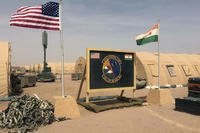Two top-notch RAND researchers, David Johnson and John Gordon, who are drilling deep into the subject of heavy armor performance in irregular and hybrid warfare, released a teaser of some initial findings from surveys of U.S., British, Canadian, Israeli and Danish land forces’ experiences over the past decade.
The bottom line: from Iraq’s city streets to to Gaza's narrow alleyways to the mountains of Afghanistan, ground troops love the intimidating presence of the 60 to 70 ton main battle tanks, their precise firepower and their unmatched utility as mobile pillboxes. Tanks provide unmatched survivability on battlefields seeded with IEDs; while a number of tanks have been lost to very large IEDs, they are more survivable, against a larger range of threats, than any other vehicle on the battlefield.
When it comes to comparing wheels versus tracks in off road mobility, there’s no contest, tracks win hands down; due to their high ground pressure, wheeled vehicles are easily mired in soft ground.
When it comes to fighting hybrid enemies, loosely defined as irregular opponents armed with high-end weaponry, tanks are an essential ingredient. “Light and medium force complement heavy forces in hybrid warfare, particularly in urban and other complex terrain, but they do not provide the survivability, lethality, or mobility inherent in heavy forces,” the RAND team writes.
The big downside of heavy armor is the greater logistical burden; while extremely robust in a toe-to-toe fight, tanks and heavy armored personnel carriers can often be mechanically fragile creatures.
Some selected input from the team’s interviews:
U.S. Marine Corps
While the Marines pressed their aged AAV-7 armored amphibian into use as a personnel carrier in Iraq, it was a far from an ideal vehicle: in one particularly ugly incident an enormous IED flung AAV-7 into the air and killed all 20 men aboard. The Marine’s Abrams tanks, on the other hand, were highly valued, particularly when facing car bombs: “These would result in a huge explosion that swept all external gear off the tank but inflicted minimal structural damage o the vehicle.” The Marines are adding an additional company to their tank battalions.
British Army
The Brits used Challengers and Warrior IFVs in southern Iraq. While no Challengers were lost during operations there, some were damaged; so much armor was added to the tanks that they eventually weighed nearly 75 tons. The Brits deployed the Warrior to Afghanistan last summer, though the researchers didn’t have much information on the vehicle’s performance on that front.
Canadian Army
The Canadians initially sent their Light Assault Vehicle (LAV) to support their infantry fighting in Afghanistan, but quickly found the vehicles were not heavily enough armed or armored against Taliban weapons. Ground commanders requested Leopard tanks, a number of which were flown to Afghanistan in early 2008. Canadian Army sources told the RAND team that the Leopards were a “major success,” noting that the tanks intimidated insurgents.
Danish Army
The Danes also sent Leopard tanks to Afghanistan to operate with its battle group fighting in the south; they also report that the tanks perform very well in that fight. The Danes said the tank’s 120mm cannon is such an accurate weapon that it helps minimize the risk of collateral damage. They also said the tanks can respond very quickly to troops in contact and the Taliban respected the tank’s firepower.
Israeli Army
The 2006 Lebanon War, the hybrid war archetype, was a learning experience for the IDF. Before the war, armored unit training was neglected because most active duty units spent most of their time battling the intifada. After the war, the IDF went “back to basics” and trained extensively on combined arms, high-intensity tactics and operations. In the wake of the 2006 wake-up, the IDF bought more and heavier tanks, adding the Merkava IV and the Namer heavy APC, based on the Merkava chassis.








